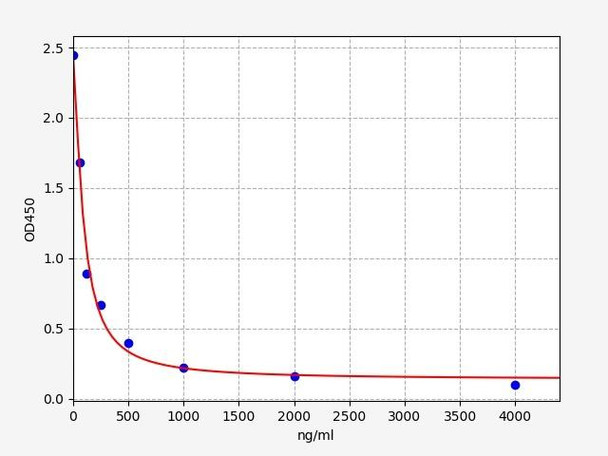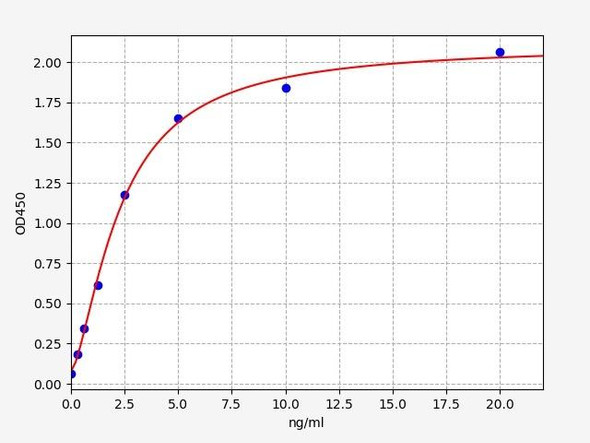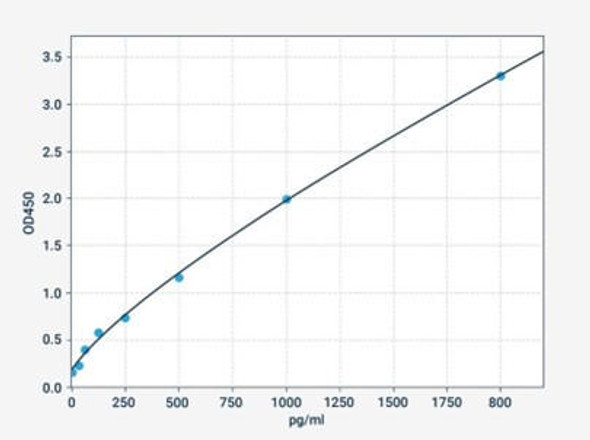AGE (Advanced glycation end-product) ELISA Kit (UNFI0101)
- SKU:
- UNFI0101
- Product Type:
- ELISA Kit
- Size:
- 96 Assays
- Sensitivity:
- 37.5ng/ml
- Range:
- 62.5-4000ng/ml
- ELISA Type:
- Competitive
- Synonyms:
- AGE, Advanced glycation end-product
- Reactivity:
- Universal
Description
AGE (Advanced glycation end-product) ELISA Kit
Key Features
| Save Time | Pre-coated 96 well plate | |
| Quick Start | Kit includes all necessary reagents | |
| Publication Ready | Reproducible and reliable results |
Overview
| AGE (Advanced glycation end-product) | |
| Product Name: | AGE (Advanced glycation end-product) ELISA Kit |
| Product Code: | UNFI0101 |
| Size: | 96 Assays |
| Alias: | AGE ELISA Kit, Advanced glycation end-product ELISA Kit |
| Target: | AGE (Advanced glycation end-product) |
| Detection Method: | Competitive ELISA, Coated with Antibody |
| Target: | AGE (Advanced glycation end-product) |
| Sensitivity: | < 37.5ng/ml |
| Range: | 62.5-4000ng/ml |
| Storage: | 4°C for 6 months |
| Note: | For Research Use Only |
Additional Information
| Recovery: | Matrices listed below were spiked with certain level of AGE (Advanced glycation end-product) and the recovery rates were calculated by comparing the measured value to the expected amount of AGE (Advanced glycation end-product) in samples. Please contact us for more information. |
| Linearity: | The linearity of the kit was assayed by testing samples spiked with appropriate concentration of AGE (Advanced glycation end-product) and their serial dilutions. The results were demonstrated by the percentage of calculated concentration to the expected. Please get in contact for more information. |
| Intra-Assay: | CV <8% |
| Inter-Assay: | CV <10% |
Kit Components
| Component | Quantity | Storage |
| ELISA Microplate (Dismountable) | 8x12 strips | 4°C for 6 months |
| Lyophilized Standard | 2 | 4°C/ -20°C |
| Sample/Standard Dlution Buffer | 20ml | 4°C |
| Biotin-labeled Antibody (Concentrated) | 120ul | 4°C (Protection from light) |
| Antibody Dilution Buffer | 10ml | 4°C |
| HRP-Streptavidin Conjugate (SABC) | 120ul | 4°C (Protect from light) |
| SABC Dilution Buffer | 10ml | 4°C |
| TMB Substrate | 10ml | 4°C (Protection from light) |
| Stop Solution | 10ml | 4°C |
| Wash Buffer (25X) | 30ml | 4°C |
| Plate Sealer | 5 | - |
Other materials required:
- Microplate reader with 450 nm wavelength filter
- Multichannel Pipette, Pipette, microcentrifuge tubes and disposable pipette tips
- Incubator
- Deionized or distilled water
- Absorbent paper
- Buffer resevoir
Protocol
*Note: Protocols are specific to each batch/lot. For the correct instructions please follow the protocol included in your kit.
Equilibrate the TMB substrate for at least 30 min at 37°C beforeuse. When diluting samples and reagents, they must be mixed completely andevenly. It is recommended to plot a standard curve for each test.
| Step | Procedure |
| 1. | Set standard, test sample and control (zero) wells on the pre-coatedplate respectively, and then, record their positions. It isrecommended to measure each standard and sample in duplicate. Washplate 2 times before adding standard, sample and control (zero) wells! |
| 2. | Add Sample and Biotin-detection antibody: Add 50µL of Standard, Blank or Sample per well. The blankwell is added with Sample Dilution Buffer. Immediately add 50 µL of biotin-labelled antibody workingsolution to each well. Cover with the plate sealer provided. Gently tap the plate to ensure thoroughmixing. Incubate for 45 minutes at 37°C. (Solutions are added to the bottom of micro-ELISA platewell, avoid touching plate walls and foaming). |
| 3. | Wash: Aspirate each well and wash, repeating the process three timesWash by filling each well with Wash Buffer (approximately 350µL)using a squirt bottle, multi-channel pipette, manifold dispenser orautomated washer. Complete removal of liquid at each step is essentialto good performance. After the last wash, remove any remaining WashBuffer by aspirating or decanting. Invert the plate and pat it againstthick clean absorbent paper. |
| 4. | HRP-Streptavidin Conjugate(SABC): Add 100µL of SABC workingsolution to each well. Cover with a new Plate sealer. Incubate for30minutes at 37°C. |
| 5. | Wash: Repeat the aspiration/wash process for five times. |
| 6. | TMB Substrate: Add 90µL of TMB Substrate to each well. Coverwith a new Plate sealer. Incubate for about 10-20 minutes at 37°C.Protect from light. The reaction time can be shortened or extendedaccording to the actual color change, but not more than 30minutes.When apparent gradient appeared in standard wells, you can terminatethe reaction. |
| 7. | Stop: Add 50µL of Stop Solution to each well. Color turn toyellow immediately. The adding order of stop solution should be as thesame as the substrate solution. |
| 8. | OD Measurement: Determine the optical density (OD Value) of each wellat once, using a microplate reader set to 450 nm. You should open themicroplate reader ahead, preheat the instrument, and set the testing parameters. |
Sample Preparation
When carrying out an ELISA assay it is important to prepare your samples in order to achieve the best possible results. Below we have a list of procedures for the preparation of samples for different sample types.
| Sample Type | Protocol |
| Serum | If using serum separator tubes, allow samples to clot for 30 minutes at room temperature. Centrifuge for 10 minutes at 1,000x g. Collect the serum fraction and assay promptly or aliquot and store the samples at -80°C. Avoid multiple freeze-thaw cycles. If serum separator tubes are not being used, allow samples to clot overnight at 2-8°C. Centrifuge for 10 minutes at 1,000x g. Remove serum and assay promptly or aliquot and store the samples at -80°C. Avoid multiple freeze-thaw cycles. |
| Plasma | Collect plasma using EDTA or heparin as an anticoagulant. Centrifuge samples at 4°C for 15 mins at 1000 × g within 30 mins of collection. Collect the plasma fraction and assay promptly or aliquot and store the samples at -80°C. Avoid multiple freeze-thaw cycles. Note: Over haemolysed samples are not suitable for use with this kit. |
| Urine & Cerebrospinal Fluid | Collect the urine (mid-stream) in a sterile container, centrifuge for 20 mins at 2000-3000 rpm. Remove supernatant and assay immediately. If any precipitation is detected, repeat the centrifugation step. A similar protocol can be used for cerebrospinal fluid. |
| Cell culture supernatant | Collect the cell culture media by pipette, followed by centrifugation at 4°C for 20 mins at 1500 rpm. Collect the clear supernatant and assay immediately. |
| Cell lysates | Solubilize cells in lysis buffer and allow to sit on ice for 30 minutes. Centrifuge tubes at 14,000 x g for 5 minutes to remove insoluble material. Aliquot the supernatant into a new tube and discard the remaining whole cell extract. Quantify total protein concentration using a total protein assay. Assay immediately or aliquot and store at ≤ -20 °C. |
| Tissue homogenates | The preparation of tissue homogenates will vary depending upon tissue type. Rinse tissue with 1X PBS to remove excess blood & homogenize in 20ml of 1X PBS (including protease inhibitors) and store overnight at ≤ -20°C. Two freeze-thaw cycles are required to break the cell membranes. To further disrupt the cell membranes you can sonicate the samples. Centrifuge homogenates for 5 mins at 5000xg. Remove the supernatant and assay immediately or aliquot and store at -20°C or -80°C. |
| Tissue lysates | Rinse tissue with PBS, cut into 1-2 mm pieces, and homogenize with a tissue homogenizer in PBS. Add an equal volume of RIPA buffer containing protease inhibitors and lyse tissues at room temperature for 30 minutes with gentle agitation. Centrifuge to remove debris. Quantify total protein concentration using a total protein assay. Assay immediately or aliquot and store at ≤ -20 °C |
| Breast Milk | Collect milk samples and centrifuge at 10,000 x g for 60 min at 4°C. Aliquot the supernatant and assay. For long term use, store samples at -80°C. Minimize freeze/thaw cycles. |
AGE Background
Advanced Glycation End-Products (AGEs) are a diverse group of compounds that form when sugars react non-enzymatically with proteins, lipids, and nucleic acids in a process known as glycation. This reaction occurs naturally in the human body but can be accelerated under certain conditions, such as hyperglycemia (high blood sugar levels) and oxidative stress.
AGE Formation
AGEs are formed through a series of chemical reactions, starting with the initial attachment of a sugar molecule to a protein, lipid, or nucleic acid. Over time, these initial glycation products undergo further modifications, resulting in the formation of more stable and irreversible structures called Advanced Glycation End-Products (AGEs).
The Role of AGEs in Aging and Diseases
AGEs are considered one of the key factors contributing to the aging process and the development of various age-related diseases. They play a significant role in the pathogenesis of chronic conditions such as diabetes, cardiovascular disease, neurodegenerative disorders, and kidney disease. The accumulation of AGEs in tissues and organs can lead to tissue damage, impaired cellular function, and the activation of inflammatory pathways. The detection and quantification of AGEs play a crucial role in understanding their role in disease development and progression.
AGE FAQs
What is an AGE ELISA Kit?
The AGE ELISA Kit is designed to measure the concentration of Advanced Glycation End-Products in biological samples. It offers a straightforward and efficient method for the quantitative detection of AGE levels, allowing researchers and clinicians to gain insights into the extent of glycation and its implications in various diseases.
What are the expected benefits of using the AGE ELISA Kit?
The AGE ELISA Kit offers several benefits, including high sensitivity, accuracy, and reproducibility. It provides a user-friendly and cost-effective solution for measuring AGE levels. By obtaining reliable data on AGE accumulation, it can aid in research, clinical decision-making, and understanding the role of glycation in various diseases.
Where can I find more information about the AGE ELISA Kit?
For more detailed information about the AGE ELISA Kit, including technical specifications, performance characteristics, and ordering details, please refer to the product brochure or contact our customer support team. We are here to assist you with any inquiries you may have.









